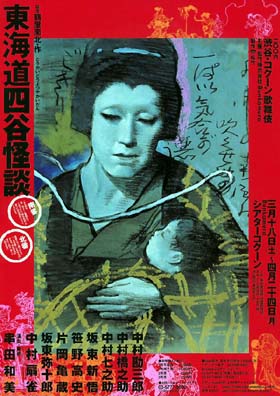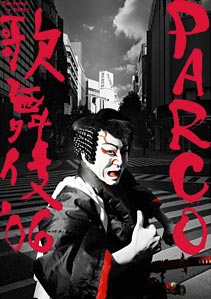| Comments |
This March program commemorates the 12th anniversary (13th memorial service)
of the death of Kataoka Nizaemon XIII with his three sons performing some of his atariyaku:
Kataoka Nizaemon and Kataoka Gat˘ play the roles of Kan Sh˘j˘ and Yojir˘ in "D˘my˘ji" and "Horikawa".
Soga no Ishidan: In the Edo period, the medieval Soga brothers,
who endured eighteen years of hardship before they avenged the death
of their father, became popular guardian gods and hundreds of plays about
their exploits appeared. This particular rarely performed play shows the
brothers confronting the two men who killed their father in a fight
scene on a set of stone steps, then the set turns over in a
spectacular transition to reveal the next scene which takes place
in the pleasure quarters. Starring Kataoka Gat˘ as Kud˘ Suketsune, the man
that had the father of the Soga brothers killed, Nakamura Shinjir˘ as the wise and
restrained Soga no Jűr˘ and Nakamura Kanjaku as the impetuous Soga no Gor˘ and
Nakamura Shibajaku as the courtesan Tora, Jűr˘'s lover.
Yoshinoyama: A dance travel scene from the epic "Yoshitsune Senbon Zakura".
Now in exile and disgrace, Yoshitsune has left his lover Shizuka in the safekeeping of his trusted retainer Tadanobu.
But she is unaware that this Tadanobu is actually a magical fox who has
disguised himself to be near the treasured drum that Shizuka carries,
a drum made from the skins of his fox parents.
Starring Matsumoto K˘shir˘ as
Tadanobu, with Nakamura Fukusuke as Shizuka.
D˘my˘ji: it is one act of a very long play about Sugawara no
Michizane (known in this play as Kan Sh˘j˘), a high-ranking imperial court
minister who was a brilliant calligrapher and scholar. But political
rivalries forced him to be exiled to distant Kyűshű, where he died.
On his way to exile, Kan Sh˘j˘ (Kataoka Nizaemon) is allowed to stop at the home of his aunt,
Kakuju (Nakamura Shikan). There he carves a statue of himself for his aunt.
But Princess Kariya (Kataoka Takatar˘) is actually Kakuju's daughter and was
adopted by Kan Sh˘j˘. She has come desperately hoping to say farewell
to him, but she is punished severely by Kakuju for having been responsible
for Kan Sh˘j˘'s downfall. At the same time, Kakuju has another daughter,
Tatsuta (Kataoka Hidetar˘) and Tatsuta's husband Sukune Tar˘ (Ichikawa Danshir˘) and
father-in-law (Kataoka Roen) are plotting to assassinate Kan Sh˘j˘ by
pretending to be the emissary to take him to exile and then killing him.
But miraculously, the statue Kan Sh˘j˘ carved comes to life and saves
his life. Finally, when the real emissary Terukuni (Nakamura Tomijűr˘) appears,
Kan Sh˘j˘ must part from his family as he goes into exile.
Horikawa: This is a very rare performance of a play that was
originally written for the puppet theatre. The courtesan Oshun and Denbŕ
are lovers, but after Denbŕ ends up killing his rival in love, they decide
that they must die together. They flee to her family home, where her blind
mother teaches music and her older brother Yojir˘ is a performer with a
trained monkey. Finally, moved by the depth of love between Oshun and Denbŕ,
her mother and brother sadly agree that they have no choice but to die and
in the final bittersweet moment, Yojir˘ says farewell with a cheerful
monkey dance, an auspicious dance to celebrate the wedding of Oshun and Denbŕ.
Starring Kataoka Hidetar˘ as Oshun,
Sakata T˘jűr˘ as Denbŕ and
Kataoka Gat˘ as Yojir˘.
Ninin Wankyű: the fabulously wealthy Wan'ya Kyűbŕ (nicknamed Wankyű) is disowned by
his family for falling in love with the courtesan Matsuyama.
Then, when she dies, he goes mad with grief and wanders through the countryside.
This dance shows him as he imagines meeting Matsuyama again and there is a
lively dance recalling their happiness together before the vision fades
and he is left alone.
Starring Living National Treasure Nakamura Tomijűr˘ as Wankyű,
a dance role for which he is famous and the popular
young onnagata
star Onoe Kikunosuke as Matsuyama.
Fudeya K˘bŕ: first performed in 1885, this play by Kawatake Mokuami
shows the disruptions in society caused by the Meiji Restoration.
In the Edo period, the samurai were on top of society, but in the new
Meiji world, a samurai unable to find a new way of becoming a success
got left behind. This play stars Matsumoto K˘shir˘ as a former samurai named K˘bŕ,
who makes a meager living making writing brushes. Since his wife has died,
he must raise his three children by himself, but his oldest daughter is blind
and the youngest boy is a baby. K˘bŕ is helped by a generous woman named Omura (Kataoka Hidetar˘),
but everything that he has is taken by a moneylender and he decides that
he and his family have no choice but to commit suicide. Suddenly, there
is the sound of merry music from a party at the house of a rich man next
door and something in K˘bŕ snaps. He starts to dance madly around,
doing the dance from the N˘ theatre of the ghost of Tomomori with a
ragged broom in place of a magnificent halbard. This scene is the
highlight of the play and is a virtuoso test of the actor's skills.
Source: Earphone Guide website
|



